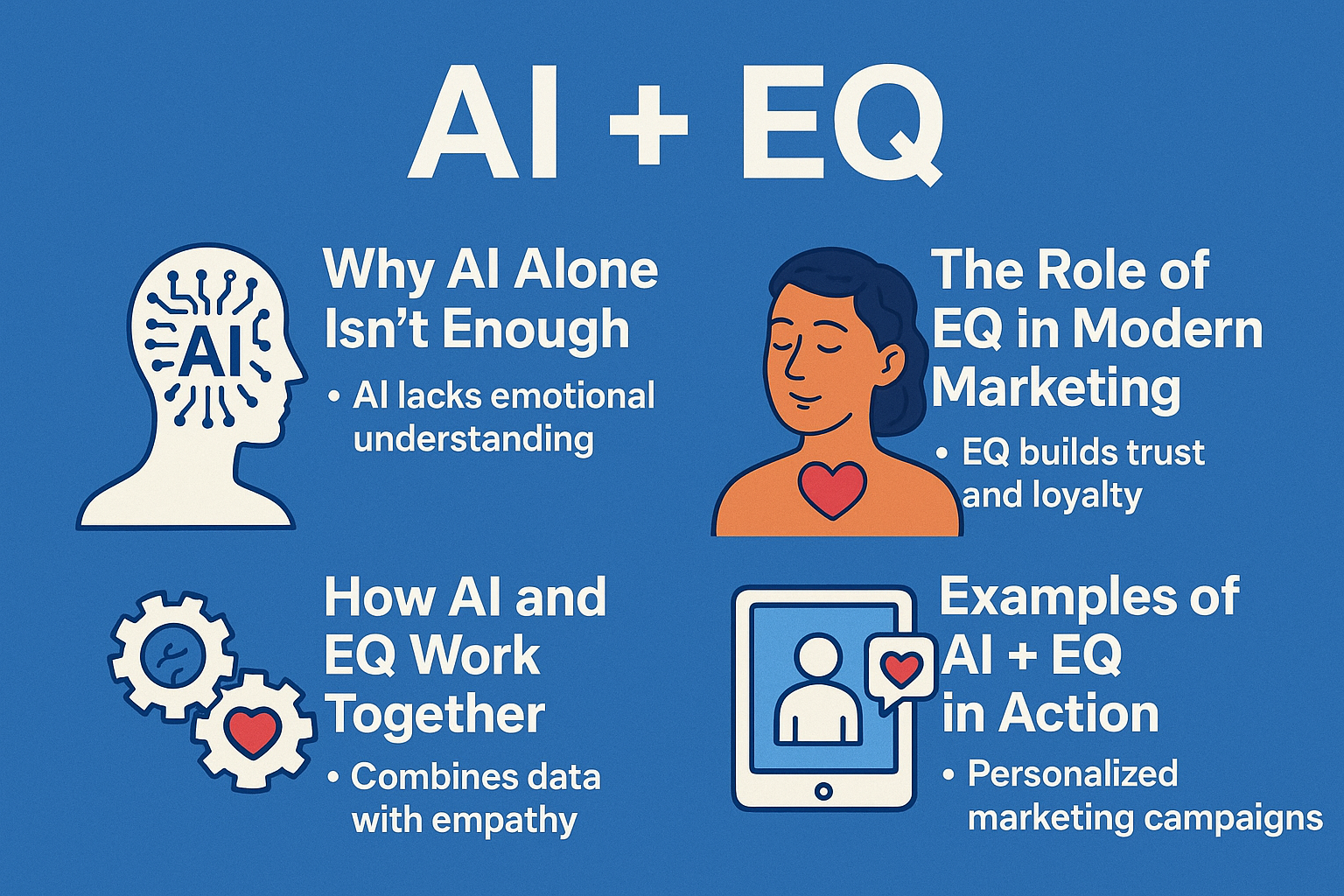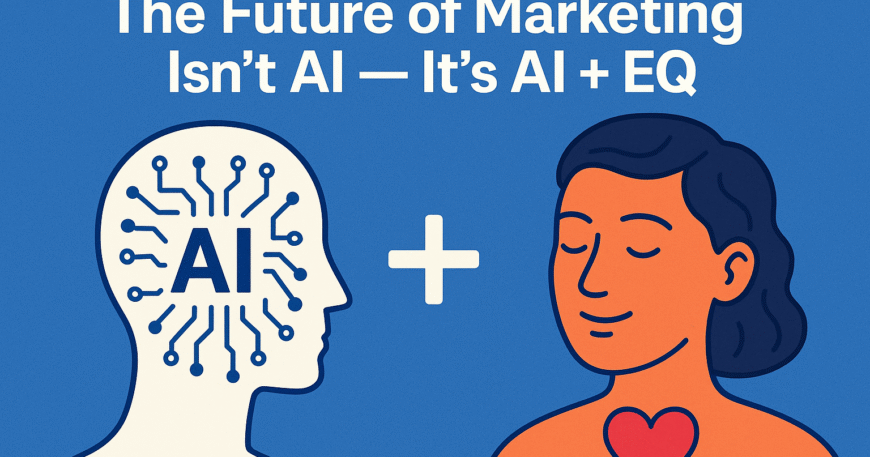Table of Contents
- Introduction
- Why AI Alone Isn’t Enough
- The Role of EQ in Modern Marketing
- How AI and EQ Work Together
- Examples of AI + EQ in Action
- The Future: Humanized Automation
- Conclusion
Introduction
Artificial Intelligence (AI) has revolutionized marketing in ways that were once unimaginable. Marketers now rely on AI for customer insights, automated campaigns, predictive analytics, and hyper-personalization. These tools provide speed and efficiency, allowing businesses to scale their efforts and stay ahead of the competition. However, while AI can tell us what customers are doing, it often struggles to understand why they do it.
That’s where Emotional Intelligence (EQ) steps in. EQ, the ability to recognize, understand, and respond to human emotions, ensures that marketing strategies don’t just optimize numbers but also touch hearts. The brands that succeed in the coming years will be those that master the blend of AI’s precision with EQ’s empathy, creating experiences that are data-informed yet deeply human.
Why AI Alone Isn’t Enough
AI can analyze enormous volumes of customer data with incredible accuracy. It can predict when a customer is most likely to click, purchase, or churn. But AI lacks the human ability to interpret nuance — the subtle motivations that drive decision-making. A customer might abandon a cart not because of price or product quality, but because of a sudden emotional shift, stress, or hesitation that data points alone can’t fully capture.
When marketers depend entirely on AI, campaigns risk becoming transactional. They may achieve short-term engagement but fail to build long-term trust. For example, an AI-driven email campaign might reach the right customer at the right time, but if the tone feels too mechanical or pushy, the customer may disengage. Numbers can tell us patterns, but they cannot capture human context, cultural sensitivities, or values that influence how people respond.
The future of marketing demands more than efficiency. It demands the ability to connect authentically, to show customers that a brand understands their world — not just their wallets.
The Role of EQ in Modern Marketing
EQ ensures that marketing remains human-centric. It empowers brands to recognize not only what customers want but also how they feel during the buying journey. Customers often remember how a brand made them feel more than the actual product or service they purchased. A company with strong EQ uses empathy, trust, and authenticity to build meaningful relationships that endure.
For instance, EQ allows marketers to communicate in a way that acknowledges a customer’s challenges rather than just pushing solutions. Instead of saying, “Here’s what you need,” EQ-driven messaging says, “We understand your struggle, and here’s how we can help.” This subtle but powerful shift builds deeper bonds and loyalty.
Additionally, EQ helps companies navigate sensitive areas like cultural differences, customer frustrations, or ethical concerns. By embedding empathy into campaigns, brands can avoid missteps that purely data-driven decisions might overlook. In an age where customer expectations are higher than ever, EQ is no longer optional — it’s essential.
How AI and EQ Work Together
The real magic happens when AI and EQ complement each other. AI provides the backbone of insights, automation, and predictive capabilities, while EQ adds the human touch that ensures messaging resonates on an emotional level.
For example, AI might identify that a customer frequently shops for baby products. Without EQ, the campaign might simply bombard them with more product recommendations. With EQ, the marketer realizes the customer may be a new parent navigating a stressful life stage. The messaging shifts from transactional (“Buy more diapers”) to supportive (“Parenthood is challenging — here’s how we can make it easier”).
Another example is customer service. AI-powered chatbots can resolve routine issues instantly, but when a frustrated customer needs empathy, human agents step in to handle the situation with care. Here, AI saves time while EQ saves relationships.
In short, AI enables scale and speed, while EQ ensures sensitivity and connection. This partnership is what transforms marketing from mechanical to meaningful.

Examples of AI + EQ in Action
The fusion of AI and EQ is already reshaping industries:
- Healthcare: Appointment reminders powered by AI become more effective when paired with empathetic language. Instead of a cold, transactional message, patients receive supportive nudges that reduce anxiety and improve adherence to treatment.
- Retail: AI recommends products based on browsing history, but EQ ensures messaging aligns with a customer’s values. A customer interested in sustainable products, for example, might receive stories highlighting eco-friendly sourcing rather than just discounts.
- Education: Learning platforms use AI to track performance and personalize content. When paired with EQ, they also encourage learners with motivational messages that recognize effort, not just outcomes, making the experience supportive rather than purely performance-driven.
- Travel & Hospitality: AI can suggest trips based on past behavior, but EQ helps frame those recommendations with aspirational storytelling, tapping into emotions like adventure, relaxation, or family bonding.
These examples demonstrate how AI provides the intelligence, but EQ provides the soul.
The Future: Humanized Automation
We are entering an era of “humanized automation.” The brands that thrive will not simply automate everything; they will know when to let AI take the lead and when to bring in the human touch. This balance creates experiences that feel both seamless and authentic.
Instead of viewing AI as a replacement for marketers, it should be seen as an enhancer of human creativity. With AI managing repetitive tasks, marketers can focus on strategy, storytelling, and building connections that AI alone cannot achieve. EQ ensures that automation doesn’t strip away humanity from brand interactions but instead elevates them.
The future of marketing will be about finding this equilibrium — where automation handles scale, and empathy handles depth. It’s not AI or EQ. It’s AI plus EQ.
Conclusion
AI has already transformed marketing, but it cannot replace the timeless power of human connection. Emotional Intelligence ensures that campaigns resonate, conversations build trust, and brands remain authentic in a crowded digital landscape.
The future belongs to businesses that embrace both — using AI for insights, precision, and personalization, while leveraging EQ for empathy, ethics, and emotional impact. Because at its core, marketing isn’t about algorithms. It’s about people — their hopes, their fears, their values, and their stories.
AI can amplify your voice, but EQ ensures your audience truly listens.




